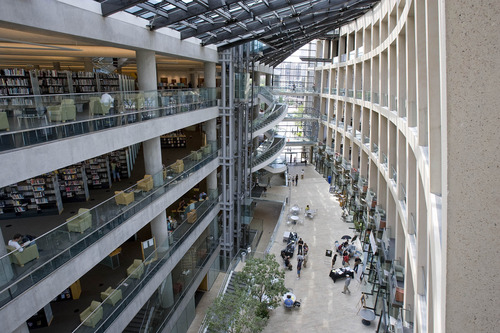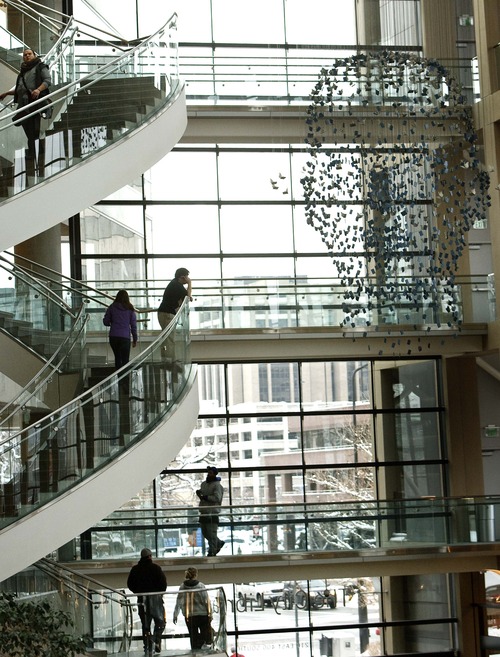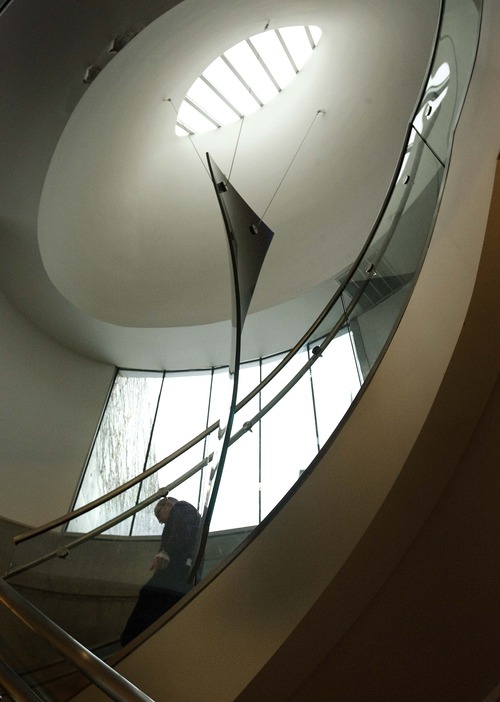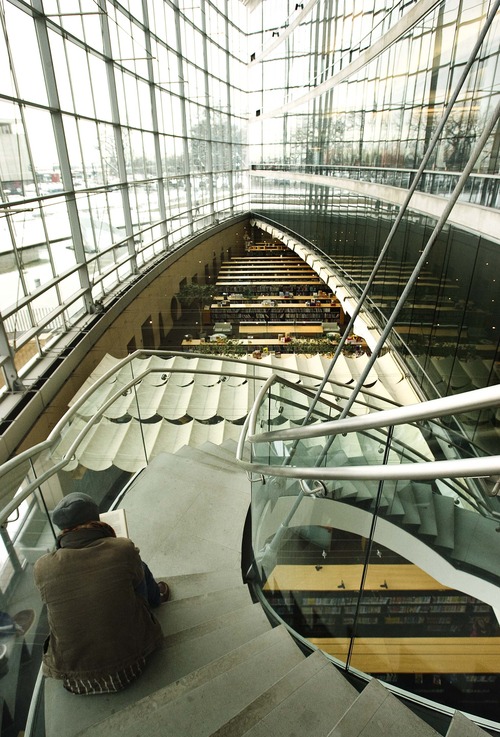This is an archived article that was published on sltrib.com in 2013, and information in the article may be outdated. It is provided only for personal research purposes and may not be reprinted.
Tommy Hamby started working at the downtown Salt Lake City Main Library as a volunteer 10 years ago — almost to the day of the building's Feb. 8, 2003, opening.
Today Hamby, now an administrative assistant at the library, has his own distinctive viewpoint on the facility's lasting impact on the city. "From a bird's eye view, the library looks like one big comma," Hamby said. In other words, a welcome pause in the sentences of hectic, every-day life in Utah's capital that run on, and on, and on.
Moshe Safdie's stunning architectural design made waves when it was unveiled as the model for Salt Lake City's downtown library. In retrospect, his bold design seems more appropriate than ever, given the vast changes that libraries nationally have withstood and adapted to in recent years.
With circulation of traditional, bound books down, and the dawn of titles downloaded through the Internet up, the Main Library has increased its focus on community events and new technologies that distribute information in all its forms to patrons who want to do more than turn pages. Computer terminals and Internet access have become library mainstays equal to books, perhaps even more so.
Never shying from its mission as a community resource open to all, the Main Library has never turned anyone from its doors —unless they prove themselves inhospitable to other patrons. Even so, in the years following the Great Recession libraries everywhere have found themselves scrambling to help patrons more in need of computer skills and resume writing than a browse through the shelves.
The number of homeless or at-risk patrons at the Main Library grew to the point that, last spring, the administration launched a program with Salt Lake County Human Services and outreach workers from Volunteers of America to direct people to social services outside library walls.
"Librarians are purveyors of information," said Errin Pedersen, the library's communications and program coordinator. "As long as you remember that, you can move quite easily from helping someone find a title to helping them gain any sort of information they might need, even a social services referral."
Through all those years, the library's interior has proved as stunning as its exterior, which features six-story walkable wall allowing patrons to enjoy, if not Hamby's "bird's-eye" view, at least a continuous 360-degree panorama of the city as they walk up the library's wall.
First-time visitors marvel, quite rightly, at the building's spacious Urban Room upon entering from either the west or east sides of the library along 400 South. But it's arguably the southeast facing "Glass Lens" that makes the lasting impression once inside.
Sloping just slightly downward next to the Library Plaza pool, its UV-filtering glass protects the library's paper volumes — reducing glare — even as it collects and disperses heat to waft across all library floors.
The library's unbridled use of light and open space couldn't contrast more starkly with its old location, which now houses The Leonardo science and technology museum across the block. When it was built in 1964, architecture of the day called for less light and more enclosed spaces.
The Main Library's design hasn't come without risk. Its spacious design has proved an unfortunate magnet for a handful of suicide attempts over the years. Hamby and Pedersen take questions about that grim fact in stride whenever hosting tours of the building. They point instead to the building's many charms.
One such feature is the fourth-floor beehive. After a City Council ordinance allowed beekeeping among residents two years ago, City Council member JT Martin introduced the library to University of Utah research biochemist Frank Whitby. A Boy Scout leader and the council's designated "city beekeeper," Whitby and his troop installed hives they still care for.
Last year, according to library communications manager Julianne Hancock, Whitby harvested 100 pounds of honey from the hives.
Hamby and Pedersen might argue that even that isn't as sweet as coming to work every day inside the library itself.
"Even if you're having a bad day at work, you forget it pretty soon," Pedersen said. "It's just this gorgeous space that's so ideal-minded."
Twitter:@Artsalt
Facebook.com/fulton.ben When you put up a building as striking as Salt Lake's Main Library, it's bound to get incorporated into popular culture. Some examples:
"Welcome to Salt Lake City" • In fall 2005, the reality-competition series "The Amazing Race" changed the format, with a "Family Edition" that traveled across the United States instead of going around the world. The ninth leg went through Utah, from Monument Valley to the Olympic ski jump in Park City. The show ended with racers walking up the Main Library's crescent wall to reach host Phil Keoghan at the "pit stop."
Bouncing off the walls • The Utah Arts Festival, which has called Library Square its home for a decade, made the Main Library building a stage in 2005. The dance troupe Bandaloop, which performs off the sides of buildings, tethered to ropes from the roof, performed beautiful works on the glass façade of the library's east face. The performance expanded Salt Lakers' ideas of what performance, and architecture, could be.
Good vibrations • In 2008, the Utah Arts Festival commissioned two 16-string "Earth Harps," designed by California artist Bill Close, which used the east side of the library as an anchor. The harps used 3,000 feet of brass musical wire, one stretching 200 feet to the east, another stretching 100 feet from the west side of the wall. Festival attendees were invited to play the harps, which according to Close, sounded like cellos.
Flying through Chicago • The 2006 Christmas comedy "Unaccompanied Minors," which followed a group of kids stranded at the Chicago airport, was filmed all over Salt Lake City including the airport and EnergySolutions Arena. But for the airport's main concourse, director Paul Feig (who later directed "Bridesmaids") used the Main Library's atrium. In an interview with The Salt Lake Tribune, Feig said of the library, "I wish this was in L.A., because I want one by my house. That is the greatest place in the world. That would be my office. I would just camp out in one of those levels every day."
Sean P. Means















